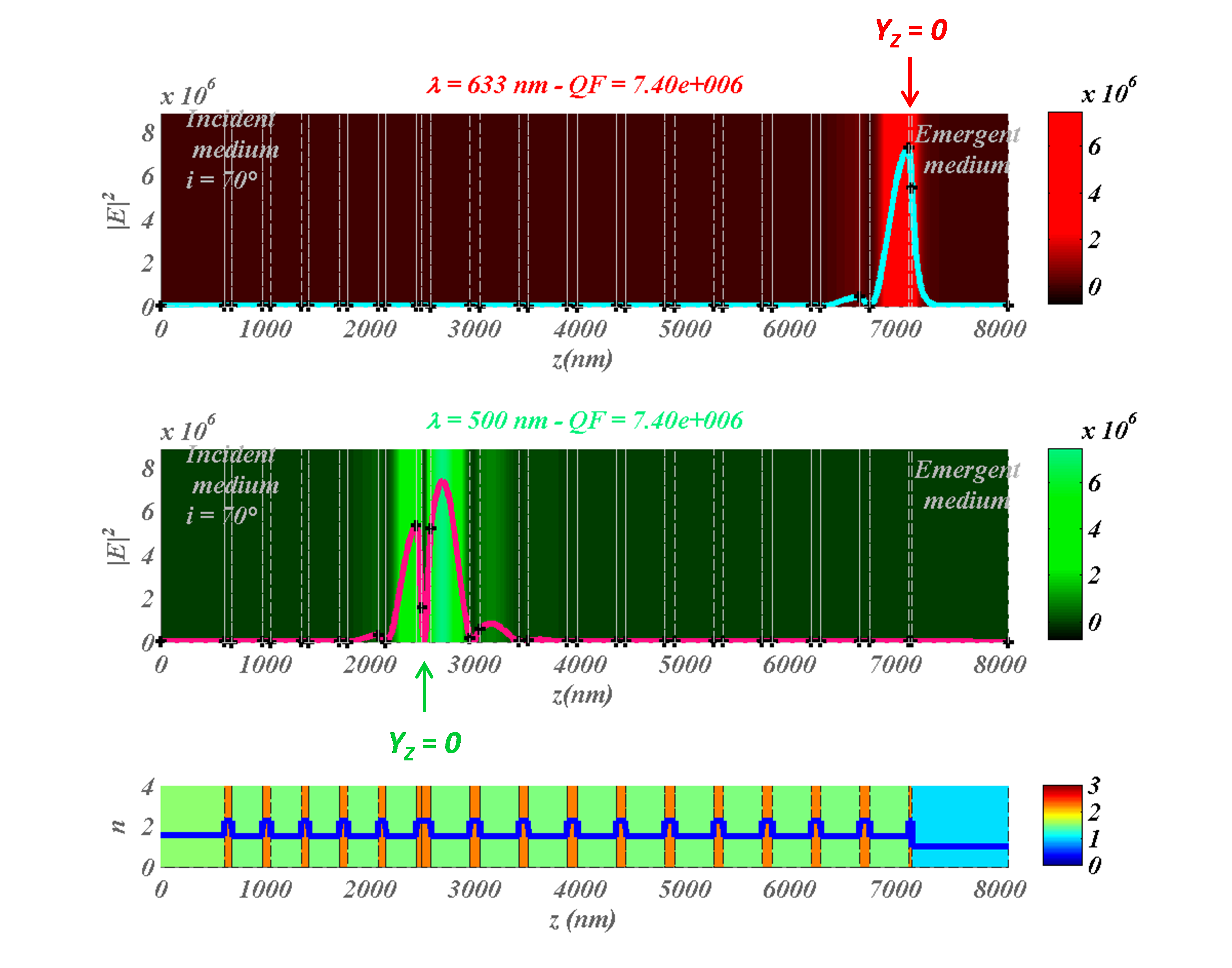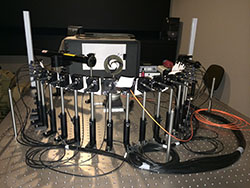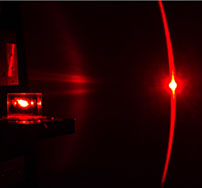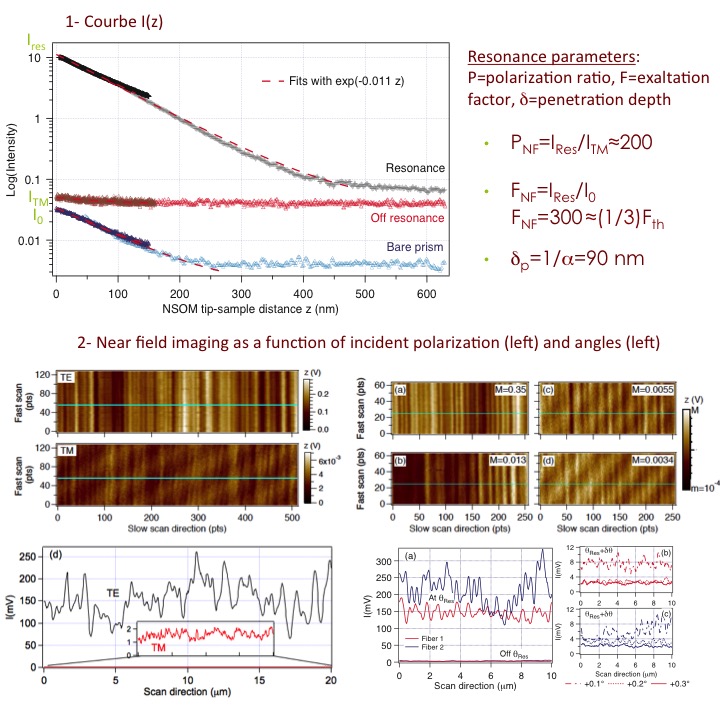Principal investigators: Myriam Zerrad & Claude Amra
Internal collaborators: Aude Lereu (RCMO), F. Lemarchand (RCMO), J. Lumeau (RCMO), M. Lequime (CONCEPT)
External collaborators: LICB, IMMM, IES, PhLAM, CPBS
Ph.D. students: Césaire Ndiaye (supported by the ANR SEEC - 2012), CIFRE fellowship under discussion with a large industrial group
Our group works, in collaboration with the RCMO group, on synthesizing optical thin films to design original components. The last example concerns the optimization of giant optical resonances supported by multi-dielectric stacks, when working under total reflection conditions; similarly to the well-known Kretschmann configuration in the plasmonic field but involving dielectrics.
The synthesis method that we have developed is entirely original and allows the existence of an optimal enhancement for arbitrary illumination conditions (incident angle, wavelength, polarization). This is a key advantage with regard to the plasmonic components (although the robustness is less) (Fig. 1). Furthermore, the field enhancement is inversely proportional to the imaginary index of the dielectrics, which leads to amplifications hitherto unmatched (several decades). The technique was recently generalized with the concept of “zero admittance” to achieve enhancement for several wavelengths and/or incident angles within the same multi-dielectric stack (article in progress).

Under these conditions, the amplification supported by these multi-dielectric oscillators is only bounded by the illumination bandwidths (spectral width and angular divergence) and by the opto-geometrical parameters accuracy of the components. The fabrication step needs chracterization feedbacks on the robustness of the resulting component. Also noteworthy, is that optimal enhancenemt can be accompanied, when needed, by a total absorption (100%) despite the low value of the imaginary indices (some 10-6) of the thin-film dielectric materials. Finally, the components can be deposited at the apex of an optical fiber to gain in flexibility and miniaturization of the full system.
To characterize such resonant components, we have been implementing a dedicated instrumentation: the One shot scatterometer (Fig. 2) that will allow measurements of the field enhancements, necessary to get feedback on the fabrication process.
This implementation is delicate and expensive, in particular because of:
the control of the spectral width down to 1pm, over a large spectral range
the low incident beam divergence required (in the order of 0.1 mrd)
the scattering process is also enhanced under resonance conditions
the accuracy required on the component geometry (i.e. complex indices, thicknesses), which can go down to 10-4 depending on the intended field enhancement.


Under these conditions, the inverse problem is complex to solve as the resonance (Fig.3) is pumped simulaneously by absorption and scattering processes and is also reduced by the geometrical inaccuracy of the component. Note that for such somponents the deposition techniques require an in situ optical control to achieve the given precisions.
Near-field measurements have been done to fulfill these investigations, with I(z) curves (Fig. 4.1) and mapping (Fig. 4.2) modes. Using the I(z) mode, we have already shown a field enhancement factor of 300, for a component designed to theoretically support an enhancement of 1000. The difference, between theory and experiment, mainly comes from the control of the incident beam divergence. Using near field mapping, we have imaged the influence of polarization and incident angle over the resonance parameters.

The targeted applications include ultra-sensitive optical sensing; low-threshold laser or power optimization of light sources; and/or high optical contraste for bio-imaging.
A project, involving dedicated resonant optical components for bio-imaging and sensing, has been submitted to the ANR JCJC 2017 call.
Publications
M. Zerrad, C. Ndiaye, A. L. Lereu and C. Amra, "Bandwidths limitations of giant optical field enhancements," to be submitted to Optica (2017)
A. L. Lereu, M. Zerrad, C. Ndiaye, F. Lemarchand and C. Amra, "Scattering losses in multidielectric structures designed for giant optical field enhancement," Appl. Opt. 53, A412 (2014)
A. L. Lereu, M. Zerrad, M. Petit, F. De Fornel and C. Amra, "Multi-dielectric staks as a platform for giant optical field," Proc of SPIE Optics+Photonics 9162, 916219 (2014)
C. Ndiaye, M. Zerrad, A. L. Lereu, R. Roche, P. Dumas, F. Lemarchand and C. Amra, "Giant optical field enhancement in multi-dielectric stacks by photon scanning tunneling microscopy," Appl. Phys. Lett. 103, 131102 (2013)
C. Ndiaye, F. Lemarchand, M. Zerrad, D. Ausserre and C. Amra, "Optimal design for 100% absorption and maximum field enhancement in thin-film multilayers at resonances under total reflection," Appl. Opt. 50, C382 (2011)
Patents
C. Amra, M. Zerrad, F. Lemarchand, "Réflecteur optique résonant à multiples couches minces de matériaux diélectriques, capteur optique et dispositif d’amplification laser comportant un tel réflecteur," French patent number: FR1656159, 2016
C. Amra, A. L. Lereu, M. Zerrad, "Capteur optique comportant un réflecteur optique résonant à multiples couches minces de matériaux diélectriques," French patent number: FR1655743, 2016
D. Ausserre, L. Roussille, C. Amra, F. Lemarchand, M. Zerrad, "Procédés optiques pour l’observation d’échantillons et pour la détection ou le dosage d’espèces chimiques ou biologiques," French patent number : FR1257279, 2013, Brevet licencié par la société WatchLive et en cours d’extension aux USA
C. Ndiaye, F. Lemarchand, M. Zerrad, C. Amra, D. Ausserré, "Optimisation de résonances plasmoniques ou multi-diélectriques à la réflexion totale," (DI 3658-02) 2010
C. Ndiaye, F. Lemarchand, M. Zerrad, C. Amra, D. Ausserré, "Supports amplificateurs de contraste," (DI 03658-01) 2009
Conferences and invited talks
C. Amra, F. Lemarchand, M. Zerrad, A. L. Lereu, "Multi-dielectric stacks as a platform for giant optical field," OIC-2016, Tucson, USA, June 2016
A. L. Lereu, "Optical field enhancement," CNRS-EWHA Winter School 2016, Seoul, Korea, January 2016
M. Zerrad, A. L. Lereu, F. Lemarchand, C. Amra, "Multi-Dielectric structures for giant optical field enhancement," OPALS 2015, Alger, Algeria, December 2015
A. L. Lereu, M. Zerrad, M. Petit, F. De Fornel, C. Amra, "Multi-dielectric stacks as a platform for giant optical field," Paper 9162-43, Active Photonic Materials VI, SPIE, San Diego, USA, August 2014
A. L. Lereu, M. Zerrad, F. Lemarchand, C. Amra, "Giant optical fields in optimized multi-dielectric stacks," C’Nano PACA Scientific Days, Porquerolles, France, June 2014
M. Zerrad, C. Ndiaye, A. L. Lereu, F. Lemarchand, C. Amra, "Multi-dielectric planar structures for giant optical field enhancement," JNMO, Evian, France May 2013
C. Amra , C. Ndiaye, M. Zerrad, F. Lemarchand, "Optimal Design for Field Enhancement in optical coatings," SPIE Optical System Design, Advances in Optical Thin Films IV, 8168-7, September 2011
Contracts
Projet AO Interne Fresnel (porteur M. Lequime) 2015-2016
Projet Région PACA Exog (porteur A. Lereu) 2013
Projet ANR SEEC (porteur C. Amra) 2007-2012
Submitted projects
Projet ANR JCJC en 2017 (en cours)
Projet ANR GOALS en 2016, avec l’IES de Montpellier, le LICB de Dijon et l’IMMM du Mans (non financé)
Projet ANR GOALS en 2015, avec l’IES de Montpellier, le LICB de Dijon et l’IMMM du Mans (non financé)
Projet ANR - PRCI MultiPAL avec la City university of Hong Kong (non financé)
Projet ANR GOALS en 2014, avec l’IES de Montpellier, le LICB de Dijon et l’IMMM du Mans (première étape validée, non financé)
PEPS INSIS Projets exploratoires 2013: MeMO : Métrologie Multimodale des exaltations Optiques géantes : du champ lointain au champ proche (non financé)
PEPS INSIS Projets exploratoires 2016 : E-CAPTE : Exaltations optiques géantes pour CApteurs oPtiques ulTra-sensibles et intEgrables (non financé)
MI – Défi instrumentation aux limites 2016 : EXOG-CAPTE - EXaltations Optiques Géantes pour CApteurs oPtiques ulTra-sensibles et intEgrables (non financé)
MI - Technologies innovantes au bénéfice de l’interdisciplinarité 2016 : e-TIRF - Microscopie TIRF exaltée par des empilements multi-diélectriques optimisés résonants (non financé)
MI – Défi instrumentation aux limites 2017 : e-TIRF - Microscopie TIRF exaltée par des empilements multi-diélectriques optimisés résonants applications aux microscopies de fluorescence multimodales. (en cours)
MI – Défi IMAG’IN 2017 (en cours) : EXTRA-TIRF
Projet A*MIDEX AAP Interdisciplinarité 2017 (en cours)
Submitted Ph.D. fellowships
CSC-China Scholarship Council program 2014, with Centrale Marseille
Optimization of giant field resonator: application to the design of new generation optical sensors
CSC-China Scholarship Council program 2015, with Centrale Marseille
Optimization of giant field resonator: application to the design of new generation optical sensors
Bourse cofinancée DGA/AMU 2014 (Accepté par la DGA)
Exaltation optique multi-diélectrique géante en espace libre
Bourse cofinancée DGA/AMU 2015
Exaltation optique multi-diélectrique géante en espace libre


 ResearchGate
ResearchGate Flux RSS
Flux RSS